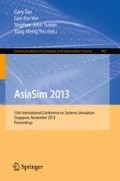Abstract
Creating complex and realistic crowd behaviors can be a difficult and time consuming task. By drawing the successful experiences of behavior-based AI and multi-agent simulation framework, this paper presents a behavior-based crowd simulation framework for riot controlling in city environment. A well-designed behavior-based prototype system is developed, which takes the advantages of the dynamics of interaction among the basis behaviors repertoires. The basis behaviors repertoires implemented by decision rules are composed of three parts, which correspond to the behaviors of the civilians, riots and soldiers respectively. Then these basis behaviors are combined into more complex behaviors by behavior selection mechanism. Eventually realistic crowd phenomena are created in the scenarios of riot controlling in city environment. We argue that this approach gives better results than conventional methods.
Access this chapter
Tax calculation will be finalised at checkout
Purchases are for personal use only
Preview
Unable to display preview. Download preview PDF.
References
Thalmann, D., Raupp Musse, S.: Crowd Simulation. Springer, London (2007)
Pelechano, N., Allbeck, J., Badler, N.I.: Virtual Crowds: Methods, Simulation, and Control. Morgan & Claypool Publishers (2008)
Jingjing, S.H.I.: Crowd Management for Large-scale Outdoor Events—Multi-agent Based Modeling and Simulation of Crowd behaviors. Ph.D thesis, The Chinese University of Hong Kong, Hong Kong, China (2006)
Bruno, S., Oussama, K.: Springer Handbook of Robotics. Springer, Heidelberg (2008)
Masciotra, A., Rodriguez, S., Lien, J.-M., Amato, N.M.: Composable group behaviors. Technical Report, TR05-006, Parasol Laboratory, Department of Computer Science, Texas A&M University (2005)
Reynolds, C.W.: Flocks, herds, and schools: A distributed behaviroal model. In: Computer Graphics, pp. 25–34 (1987)
Shell Dylan, A., Mataric Maja, J.: Behavior-based methods for modeling and structuring control of social robots. In: Cognition and Multi-Agent Interaction: From Cognitive Modeling to Social Simulation. Cambridge university press (2005)
Pan, X.: Computational Modeling of Human and Social Behavior for Emergency Egress Analysis, Ph.D. Thesis, Stanford University (2006)
Pan, X., Han, C.S., Dauber, K., Law, K.H.: A Multi-Agent Based Framework for the Simulation of Human and Social Behaviors during Emergency Evacuations. AI & Society 22, 113–132 (2007)
Rodriguez, S., Amato, N.M.: Behavior-based evacuation planning. In: IEEE International Conference on Robotics and Automation Anchorage Convention District, Anchorage Alaska (2010)
Varol, K.: Modeling autonomous agents in military simulations. Ph.D. Thesis, University of Central Florida (2006)
McKenzie, F., Kruszewski, M.P.P., Gaskins, R., Nguyen, Q.A., Seevinck, J., Weisel, E.: Integrating crowd-behavior modeling in military simulation using game technology. Simulation & Gaming 39(1) (2008)
Wong, Y.H.: Ignoring the Innocent: Noncombatants in Urban Operations and in Military Models and Simulations. Pardee RAND Graduate School (2006)
Levesque, J., Cazzolato, F.: Simulating Civilians for Military Training: A Canadian Perspective, http://www.google.com.hk/gwt/x?gl=CN&hl=zh-Hans-CN&u=http://ftp.rta.nato.int/public//PubFullText/RTO/MP/RTO-MP-HFM-202///MP-HFM-202-05.doc
Lien, J.-M., Rodriguez, S., Malric, J.-P., Amato, N.M.: Shepherding behaviors with multiple shepherds. In: Proc. IEEE Int. Conf. Robot. Autom (ICRA), pp. 3413–3418 (2005)
Olfati-Saber, R.: Flocking for multi-agent dynamic systems: algorithms and theory. IEEE Transactions on Automatic Control 51(3), 401–420 (2006)
Author information
Authors and Affiliations
Editor information
Editors and Affiliations
Rights and permissions
Copyright information
© 2013 Springer-Verlag Berlin Heidelberg
About this paper
Cite this paper
Jia-hong, L., Meng, L., Yue-wen, F., Mei, Y., Shi-lei, L. (2013). A Behavior Based Crowd Simulation Framework for Riot Controlling in City Environment. In: Tan, G., Yeo, G.K., Turner, S.J., Teo, Y.M. (eds) AsiaSim 2013. AsiaSim 2013. Communications in Computer and Information Science, vol 402. Springer, Berlin, Heidelberg. https://doi.org/10.1007/978-3-642-45037-2_6
Download citation
DOI: https://doi.org/10.1007/978-3-642-45037-2_6
Publisher Name: Springer, Berlin, Heidelberg
Print ISBN: 978-3-642-45036-5
Online ISBN: 978-3-642-45037-2
eBook Packages: Computer ScienceComputer Science (R0)

